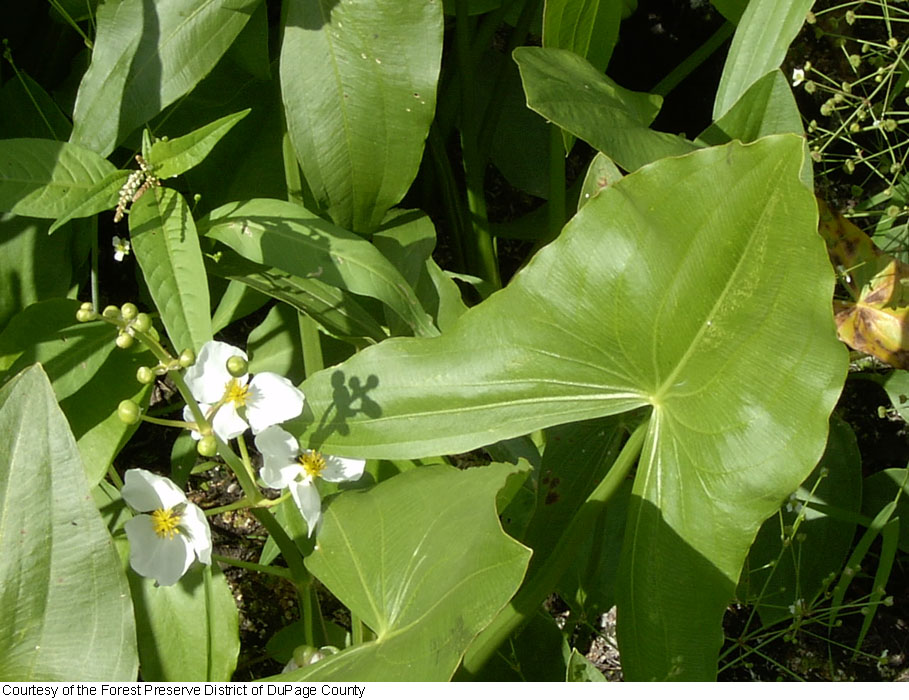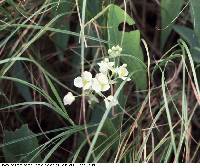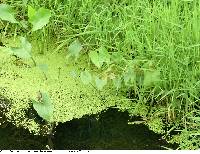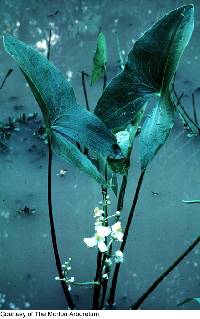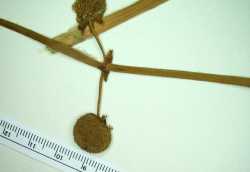|
|
|
|
Family: Alismataceae
broadleaf arrowhead
[Sagittaria chinensis Sims, moreSagittaria engelmanniana subsp. longirostra (Micheli) Bogin, Sagittaria esculenta Howell, Sagittaria latifolia var. obtusa (Engelm.) Wiegand, Sagittaria latifolia var. pubescens (Torr.) J.G.Sm., Sagittaria longirostra (Micheli) J.G.Sm., Sagittaria ornithorhyncha Small, Sagittaria planipes Fernald, Sagittaria pubescens Muhl., nom. nud., Sagittaria variabilis Engelm., Sagittaria variabilis f. obtusa E.L.Rand & Redfield, Sagittaria variabilis var. obtusa Engelm., Sagittaria viscosa C.Mohr] |
Herbs, perennial, to 45 cm; rhizomes absent; stolons present; corms present. Leaves emersed; petiole triangular, erect to ascending, 6.5--51 cm; blade sagittate, rarely hastate, 1.5--30.5 ´ 2--17 cm, basal lobes equal to or less than remainder of blade. Inflorescences racemes, rarely panicles, of 3--9 whorls, emersed, 4.5--28.5 ´ 4--23 cm; peduncles 10--59 cm; bracts connate more than or equal to ¼ total length, elliptic to lanceolate, 3--8 mm, delicate, not papillose; fruiting pedicels spreading, cylindric, 0.5--3.5 cm. Flowers to 4 cm diam.; sepals recurved to spreading, not enclosing flower or fruiting head; filaments cylindric, longer than anthers, glabrous; pistillate pedicellate, without ring of sterile stamens. Fruiting heads 1--1.7 cm diam; achenes oblanceoloid, without abaxial keel, 2.5--3.5 ´ to 2 mm, beaked; faces not tuberculate, wings absent, glands (0--)1(--2); beak lateral, horizontal, 1--2 mm. 2n = 22. Flowering summer--fall. Wet ditches, pools, and margins of streams and lakes; 0--1500 m; Alta., B.C., Man., N.B., N.S., Ont., P.E.I., Que., Sask.; Ala., Ark., Calif., Colo., Conn., Del., D.C., Fla., Ga., Ill., Ind., Iowa, Kans., Ky., La., Maine, Md., Mass., Mich., Minn., Miss., Mo., Nebr., N.H., N.J., N.Y., N.C., N.Dak., Ohio, Okla., Pa., R.I., S.C., S.Dak., Tenn., Tex., Vt., Va., W.Va., Wis.; c, s Mexico; Central America (Guatemala); South America (Colombia, Ecuador, Venezuela). Sagittaria latifolia has been divided into numerous species and varieties. It was divided into two varieties, based upon the presence of pubescence over the entire vegetative plant (C. Bogin 1955; K. Rataj 1972). We have examined numerous specimens and found that many from the southeastern United States are pubescent; we believe that this character alone is insufficient for recognition of the varieties.
Perennial aquatic herb to 45 cm tall Leaves: emersed. The erect to ascending stalk is 6.5 - 50 cm long and triangular but round near the base. Blade 1.5 - 40 cm long, 0.5 - 25 cm wide, linear to arrowhead-shaped, with lobes equal to or shorter than the rest of the blade. Inflorescence: emersed, singly stalked along a central axis (raceme), rarely with loosely branched stalks (panicle), 4.5 - 28.5 cm long, 4 - 23 cm wide, arising from a 10 cm - 0.59 m long stalk, with two to fifteen whorls of flowers. Flowers: either male or female, found on the same plant (monoecious), with recurved or spreading sepals 5 - 11 mm long and three white petals 1 - 2 cm long. Male flowers are borne near the top of the inflorescence, having smooth filaments longer than the anthers. Female flowers found near base of inflorescence, with spreading fruiting stalks 0.5 - 3.5 cm long. Fruit: a spherical cluster of achenes 1 - 1.7 cm wide. Each achene is 2.5 - 4 mm long, to 2 mm wide, narrow and inversely egg-shaped, with a horizontal beak 0.6 - 2 mm long. Bracts: 4 - 15 mm long, boat-shaped with a rounded to short pointed tip, delicate, fused at least one-quarter the length. Similar species: Sagittaria latifolia, Sagittaria brevirostra, Sagittaria cuneata, and Sagittaria montevidensis ssp. calycina all have emersed arrowhead-shaped leaves and filaments lacking scales. Sagittaria brevirostra also has mostly emersed leaves, but they are nearly all arrowhead-shaped. The edges of S. brevirostra achenes are minutely shallow toothed and the beaks are ascending. Sagittaria cuneata has submersed ribbon-like leaves, floating lance- to arrowhead-shaped leaves, emersed arrowhead-shaped leaves, and achenes with short, erect beaks. Sagittaria montevidensis ssp. calycina has linear submersed leaves, arrowhead-shaped emersed leaves, and achenes with horizontal beaks. While the other species above have separate male and female flowers and reflexed or spreading sepals, S. montevidensis ssp. calycina has male and bisexual flowers. The bisexual flowers are distinguished by a ring of sterile stamens and appressed sepals. Flowering: late June to early September Habitat and ecology: Common in muddy marshy edges of ponds and streams. This species is sometimes found in swamps, sloughs, and pools in bogs. It is tolerant to pollution and can be aggressive, forming solid stands in artificial waterways such as canals. Occurence in the Chicago region: native Etymology: Sagittaria comes from the Latin word sagitta, meaning arrow, referring to the leaf shape. Latifolia means "with broad leaves." Author: The Morton Arboretum Vegetatively very plastic, ±erect and with large, edible tubers; lvs sagittate or sometimes narrow and phyllodial, the blade 5-40 נ0.5-25 cm, with narrow or broad lobes; scape 1-12 dm, with 2-15 whorls of fls, sometimes branching at the lowest whorl, the upper fls staminate on short pedicels, the lower pistillate on longer, ±ascending pedicels; bracts 4-15 mm, boat-shaped, broad-based, rounded above or broadly acute, 4-15 mm, papery but friable at the tip; sep ovate, obtuse, 5-11 mm, reflexed in fr; pet 1-2 cm; stamens 20-40, on slender, glabrous filaments; achenes 2.5-4 mm, winged on the margins only, or with a poorly developed wing on each face, with (var. latifolia) or without (var. pubescens) resin-ducts; beak 0.6-1.8 mm, set at essentially right angles to the body; 2n=22. Abundant in swamps, ponds, and streams; N.S. and Que. to s. B.C., s. to trop. Amer. July-Sept. The widespread, glabrous var. latifolia is uncommon in the principal range of the stellate-hairy var. pubescens (Muhl.) J. G. Sm., which occurs chiefly from the mts. to the coast, from s. Pa. to W.Va. and Ga., w. occasionally to O., Tenn., and Tex. Gleason, Henry A. & Cronquist, Arthur J. 1991. Manual of vascular plants of northeastern United States and adjacent Canada. lxxv + 910 pp. ©The New York Botanical Garden. All rights reserved. Used by permission. |


